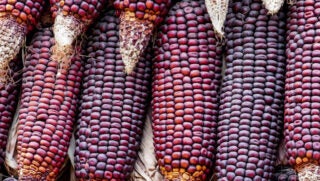Soybean fields infested with soybean cyst nematode (SCN) may look healthy above ground, but adult SCN females can be detected on the roots of infected plants during the growing season, which may be contributing to the development of sudden death syndrome (SDS). The adult SCN females fill with eggs and eventually die, changing into hardened cysts that protect the eggs in the soil.
Leaders with The SCN Coalition encourage soybean growers to check roots now to determine if their current SCN management program is effective. To scout for SCN during the growing season, gently uproot soybean plants and carefully examine the roots for white females, says North Dakota State University Plant Pathologist Sam Markell. “Use a shovel to dig up soybean plants and then gently remove the soil around the roots,” he says. “If you pull the roots, the SCN females can fall off.
“Females on roots are much smaller than nitrogen-fixing nodules and can be difficult to see,” adds Markell. “A hand lens and a flashlight make it easier to detect females.”
The SCN life cycle is repeated through the growing season. “In North Dakota, it might be only two or three, but in Missouri, it might be as many as six,” adds Markell. “Each time they go through that cycle, the egg levels may increase in the field.”
SCN increases risk of SDS
Soybean growers scouting fields may also discover SDS rearing its ugly head but may not realize the two yieldgrabbing pathogens have a synergistic relationship. In a study published in 2019, Michigan State University researchers concluded SCN has a significant association with SDS development.
SDS, caused by the fungal pathogen Fusarium virguliforme, can generate significant yield loss. Like SCN, soybean roots may be infected with F. virguliforme and foliar symptoms may be absent, raising the question of “hidden” yield loss. However, when conditions are favorable for SDS, dramatic foliar symptoms can develop, and yield losses are much greater. These SDS foliar symptoms first appear as small, pale green to yellow areas on the leaves during late vegetative or early productive growth stages. As SDS progresses, the areas between the leaf veins turn yellow and eventually die and turn brown, although the veins remain green.
While SCN reproduction thrives in dry soils, SDS prefers cooler and wetter conditions. Michigan State University Plant Pathologist Martin Chilvers wants soybean growers to understand that regardless of what Mother Nature delivers during the growing season, these two pathogens appear to be in competition for nutrients within the root, either directly or indirectly.
“The data from the 2019 study reveals the added pressure of SCN can increase the risk of developing severe SDS in a density-dependent manner. In other words, SCN can exacerbate SDS,” says Chilvers.
Although it should be remembered that severe SDS can develop in the absence of SCN, Chilvers encourages soybean growers who detect SDS during the growing season — or know areas in fields that have had SDS in the past — to add SCN to their fall soil sampling program. “I want to stress that SDS worsens as SCN population densities rise,” he adds. “We want soybean growers to understand this relationship, and I hope this gives them another reason to test soil for SCN.
“In the future, we hope to also test soil for F. virguliforme,” adds Chilvers. “The study that we conducted was a proof of principle which demonstrated that our assay could detect hotspots of SDS within a field. We are now collaborating with others to expand the application of our assay to many soil types and locations to see if the assay can be routinely used as an SDS risk prediction tool, which would aid as a decision tool for the selection of SDS-resistant varieties and SDS-specific seed treatments.”
Weather impacts SCN life cycle
Iowa State University Nematologist Greg Tylka is concerned that last year’s hot and dry weather pattern is being repeated in some areas because weather during the growing season impacts the SCN life cycle. “We have data verifying that SCN is worse in hot, dry years,” he says. “The nematode is reproducing much quicker, raising population densities.
“Many soybean growers have faced back-to-back years of hot and dry conditions,” adds Tylka. “Once again, I would expect SCN soil samples collected this fall to reveal higher SCN population densities. In a traditional corn-soybean rotation, accelerated nematode reproduction would be a consideration the next time you plant soybeans. I urge growers to work with their agronomist or crop consultant to fine-tune their SCN active-management strategy.”
Active management starts with a soil test
“Gaining ground in the battle against SCN starts by knowing the SCN situation in each field where soybeans are grown,” says Tylka. “Active SCN management starts with a soil test.”
In areas where the most common source of SCN resistance, known as PI 88788, has been used for more than 30 years, SCN populations are reproducing and having a negative impact on soybean yields. Research from 15 years of variety trial experiments in farmers’ fields in Iowa showed that as SCN reproduction increases on PI 88788, yields decrease by as much as 14 bushels per acre — equivalent to a 23% yield reduction.
In addition to testing soil for SCN, The SCN Coalition encourages soybean growers to rotate varieties with different sources of SCN resistance, rotate to non-host crops such as corn and wheat at least every other year, and consider using a nematode-protectant seed treatment. State-specific advice is available by visiting The SCN Coalition website.


